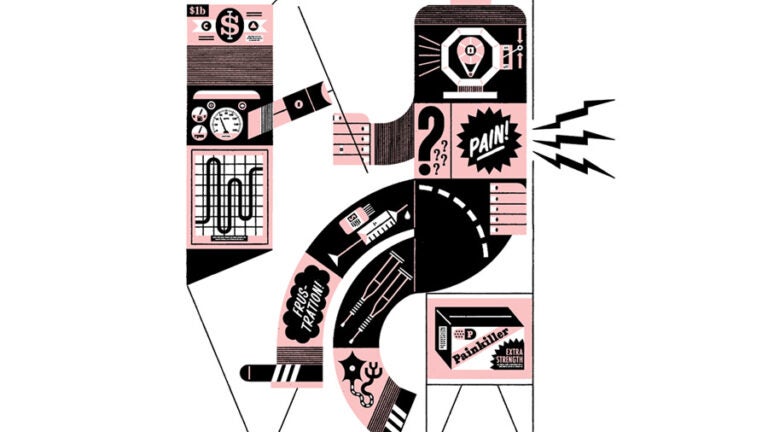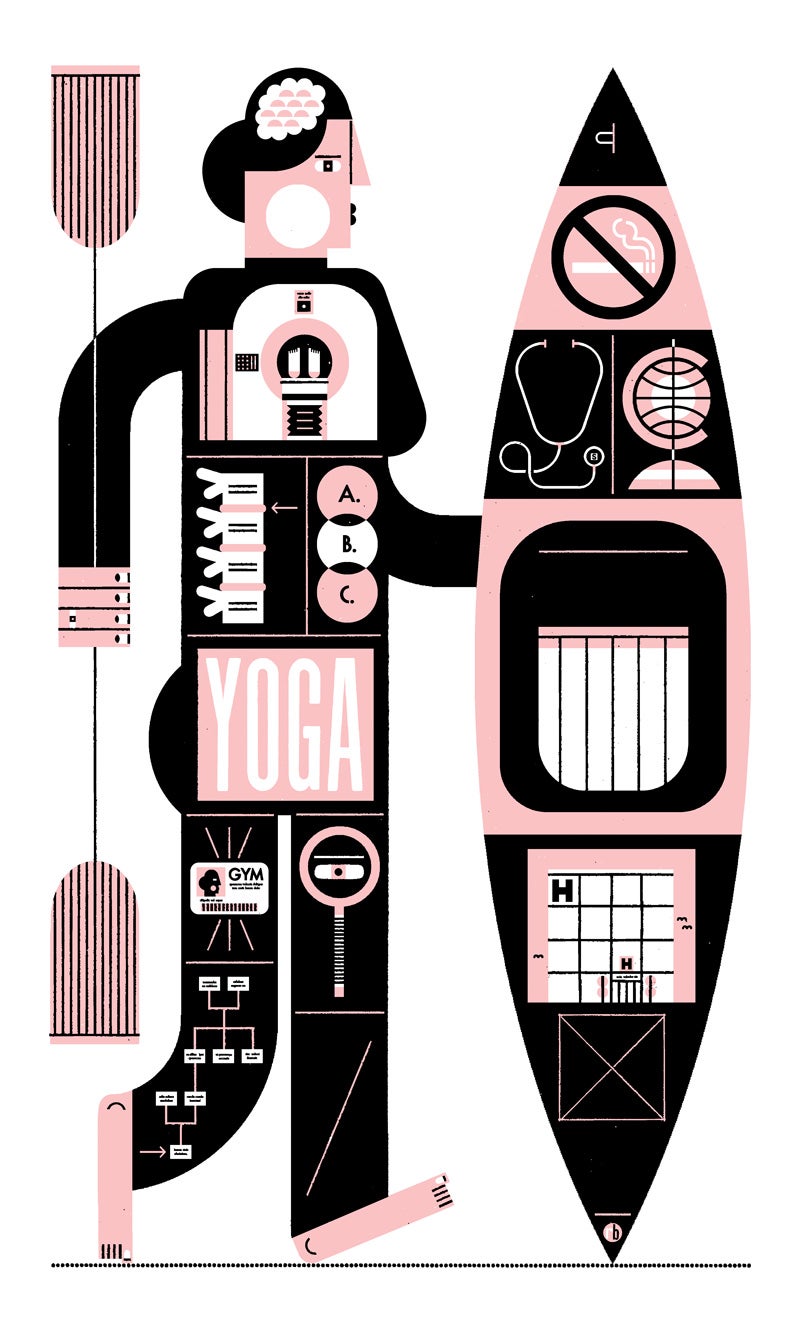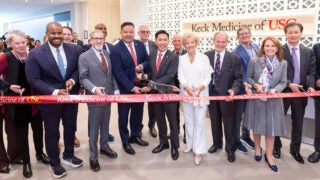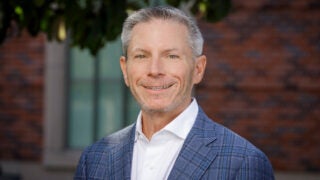
(Illustrations/Raymond Biesinger)
Low Back Pain? There Might Be Options Besides Surgery
Chances are you’ve had an aching back. Sometimes it takes expert detective work and an open mind to figure out why — and fix it for good.
Jennifer Crawford loved racing across muck-filled obstacle courses. She scaled 15-foot walls, crawled through mud and carried her teammates on her shoulders in competitive events — all while covering up to 12 miles.
But soon, low back pain became the one barrier she couldn’t conquer.
“I suffered for so long — seven years before I gave up and started looking for real help,” Crawford says.
Her back pain started in 2012, just before she turned 40. She couldn’t get comfortable, whether sitting, standing or lying down. On her drive to work as a nursing director at a retirement community in Santa Clarita, California, she needed to readjust her seat every few minutes or stop driving. Soon, she ached all over. Then the toes on her left foot started going numb.
“I didn’t know what it was like to not be in pain,” she says. “It was exhausting.”
Crawford isn’t alone. Low back pain is the leading cause of disability worldwide, outpacing heart disease, diabetes, asthma and mental health problems. Americans spend some $50 billion a year trying to alleviate their suffering.
For many, the pain is brief and recedes without medical intervention. For others, the misery becomes severe — and sometimes, so do the solutions. Chronic low back pain is one of the most common reasons physicians prescribe opioid drugs, which may alleviate some pain but can’t address its root causes.
Some pain sufferers see surgery as an obvious answer. But orthopaedic surgeon Jeffrey Wang and neurosurgeon John Liu, co-directors of the USC Spine Center at Keck Medicine of USC in Los Angeles, say an operation is typically the last resort.
“A patient may be frustrated by their pain,” Liu says. “But our wanting to help a patient feel better is not an indication for surgery. We have to dive deeper and find the correct structural explanation for their pain.”
Liu, a pioneer in minimally invasive surgery, considers each patient and asks himself: “If this were my mom, my dad or my wife in front of me, what would I offer them?”
Making that decision is complicated, Wang says. “Surgery doesn’t always work, and it won’t cure every aspect of your life.”
Yet some facilities pursue aggressive treatment right away. As a result, only 70% of operations for low back pain succeed. Wang puts the problem simply: “Surgeons need to better select patients who will do well with surgery.”
Low Back Pain Treatment Starts with Detective Work
Treatment starts with a diagnosis. But for many, the source of trouble — what Wang calls “the pain generator” — often remains elusive. Sometimes doctors find a physical cause, like arthritis, degenerative discs, fractures and tumors. Or they might trace it to emotional triggers, like stress or depression.
“The first thing to understand about back pain is it’s a symptom, not a disease in itself,” says USC physical therapist Justin Lantz, who specializes in spinal problems.
At USC, back care can start with rehabilitation physicians, known as physiatrists, or physical therapists with advanced specialty training. “We take a biopsychosocial approach,” says Lantz, assistant professor of clinical physical therapy at the USC Division of Biokinesiology and Physical Therapy and clinical family medicine at the Keck School of Medicine of USC. That means they consider everything from a patient’s family life to whether they sit at a desk all day.
These professionals analyze how a person walks, sits, sleeps and works, as well as their sense of balance and core abdominal strength, to pinpoint potential pain sources and solutions. Their prescriptions include conservative treatments like exercise, physical therapy, meditation, other stress-reduction techniques and counseling — because depression can trigger back pain or make it harder to resolve. Says Lantz: “We’re trying to change people’s lifestyles and how they function throughout the day as we teach them to be more mindful of their bodies.”
Relief After Doctors Diagnose Disc Dysfunction

Crawford tried physical therapy for her back pain. Even as it worsened, she avoided pain pills. Then an MRI suggested the culprit: A few of the sponge-like discs between her spine’s vertebrae bulged out of their slots. She opted for several steroid injections. That reduced the inflammation in her spinal nerves and brought her some relief — a “Band-Aid solution,” she says, that kept her going for nearly a year.
Still, her legs got weaker. Then, as the weakness spread to her bladder, she worried she might become incontinent or paralyzed.
When her primary care doctor asked if she wanted to see a specialist, the 46-year-old was ready. Tests at the USC Spine Center confirmed that she had a condition called “radiculopathy”— a pinched nerve, the likely source of her leg pain and numbness. Because a disc in her lower back had degenerated, the surrounding vertebrae had sandwiched and then pressed on the nerve.
In September 2019, Wang performed an operation to relieve that pressure and stabilize her vertebrae. In the minimally invasive procedure — an anterior lumbar interbody fusion — the surgeon approaches the patient’s spine through the abdomen to avoid harm to the back muscles and nerves. Wang removed the last disc in Crawford’s lower spine and inserted a carbon-fiber cage that held a bone graft. As her body healed, the implant would stabilize and realign her spine.
Back Pain Treatments Might Come from the Lab
Will we ever “cure” back pain? After all, our discs naturally lose cushioning and flexibility as we age. Making that dream come true, Wang says, “requires addressing the problem on a biological basis.”
In his lab, he studies ways to intervene in the spine’s normal aging. He activates damaged discs by injecting stem cells with different genes and growth factors in search of the best combination to encourage spinal cells to keep themselves healthy. “The ultimate goal is to reverse the process of degeneration, stop arthritis and make the spine younger again,” he says.
That day is still in the future. Crawford’s recovery is very much in the present, and it’s working. As soon as she woke from her operation, she knew something was different. The pain she carried for years had vanished. “I wish I had done the surgery earlier,” she says.
At her three-month checkup, her spine looked so healthy that doctors cleared her to start light jogging. By early May, she got her kayak out, strapped it to her car and tackled the ocean waves off Ventura.
“I’m forgetting what it’s like to be in pain,” she says. “It’s pretty much a miracle.”



